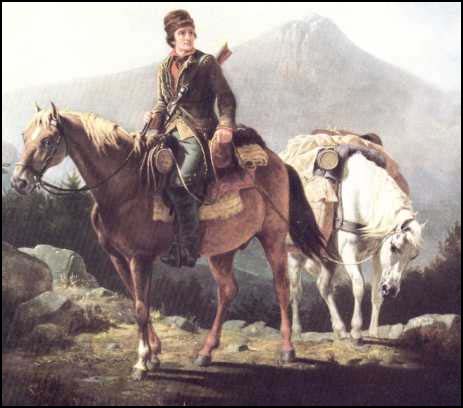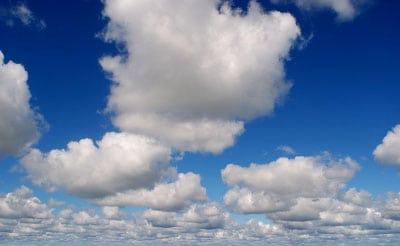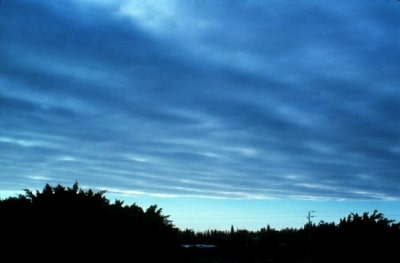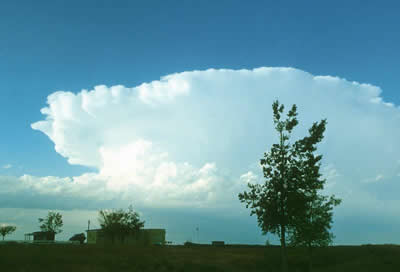
Technology has brought the world a long way, enabling us to consume more information in a few short minutes on Google Mobile than folks decades ago could locate in a week by plowing through books at the local library. And yet, with all this readily available information and the focus on being able to find information, the need to actually know and retain information has been decidedly diminished. There is still something to be said, however, for retaining the knowledge and skills that the men of yesteryear needed to survive, such as navigating by compass or starting up a respectable campfire. With that in mind, and with hunting season just around the corner, let’s look to the skies and sharpen up our skills in forecasting the weather.
Weather forecast for tonight: dark. Continued dark overnight, with widely scattered light by morning. –George Carlin
Now keep in mind that if the national weatherman equipped with Doppler radar and satellite imagery gets it wrong from time to time, you will too. Taking that into consideration, it is probably best to avoid making high dollar wagers with your buddies when you are confident that it will begin storming in the next few minutes. And yet, by utilizing nature’s telltale signs, you can make some fairly safe assumptions regarding what is around the corner weather-wise. Let’s take a look at some of the basics:
Cloud signs
As far as nature’s weather signs go, clouds will provide you with the most accurate indicators of things to come. Clouds are essentially water droplets or ice crystals (depending on altitude) that mass together in the atmosphere. There are many types of clouds, far too many to list, but some of the basic cloud types can indicate what weather patterns to be prepared for.
Cumulus
 Cumulus clouds themselves are most often associated with pleasant weather. It is cumulus clouds that often take the shape of various characters in the imagination of creative youngsters as a result of their puffy, continuously changing appearance. While they are a sign of agreeable weather, it is not uncommon for cumulus clouds to form into cumulonimbus clouds, aka thunderheads, which are a sure sign that it is time to batten down the hatches.
Cumulus clouds themselves are most often associated with pleasant weather. It is cumulus clouds that often take the shape of various characters in the imagination of creative youngsters as a result of their puffy, continuously changing appearance. While they are a sign of agreeable weather, it is not uncommon for cumulus clouds to form into cumulonimbus clouds, aka thunderheads, which are a sure sign that it is time to batten down the hatches.
Stratus
 Stratus clouds are flat and featureless and often completely blanket the sky. As opposed to cumulus clouds, which are flat on the bottom and rise dramatically on the tops, stratus clouds are flat both above and below. While they usually do not indicate extreme weather to come, they do often produce a light drizzle or flurries.
Stratus clouds are flat and featureless and often completely blanket the sky. As opposed to cumulus clouds, which are flat on the bottom and rise dramatically on the tops, stratus clouds are flat both above and below. While they usually do not indicate extreme weather to come, they do often produce a light drizzle or flurries.
Cirrus
 Cirrus clouds are high altitude clouds which resemble wispy brush strokes. When the wisps curl at the end, they are often referred to as mare’s tails. These clouds are regularly associated with approaching storms, but can also come directly after a thunderstorm has passed.
Cirrus clouds are high altitude clouds which resemble wispy brush strokes. When the wisps curl at the end, they are often referred to as mare’s tails. These clouds are regularly associated with approaching storms, but can also come directly after a thunderstorm has passed.
Nimbus
 Nimbus clouds can refer to any of the above clouds which have taken on a dark color, thus indicating high moisture levels within the cloud and rain to come. For example, a cumulonimbus cloud is a cumulus cloud that is uncharacteristically dark and foreboding, and is associated with thunderstorms. Cumulonimbus clouds often rise like towers into the sky and sometimes take the shape of an anvil, with the longer end of the anvil head typically pointing in the direction the storm is heading.
Nimbus clouds can refer to any of the above clouds which have taken on a dark color, thus indicating high moisture levels within the cloud and rain to come. For example, a cumulonimbus cloud is a cumulus cloud that is uncharacteristically dark and foreboding, and is associated with thunderstorms. Cumulonimbus clouds often rise like towers into the sky and sometimes take the shape of an anvil, with the longer end of the anvil head typically pointing in the direction the storm is heading.
Proverbs That Stand the Test of Time
Weather proverbs are likely nearly as old as language itself, with the earliest recorded proverb dating back to the New Testament of the Bible when Jesus noted that “When evening comes, you say, ‘It will be fair weather, for the sky is red,’ and in the morning, ‘Today it will be stormy, for the sky is red and overcast.’’’ (Matthew 16:2). While some proverbs add up to nothing more than old wives’ tales, many are based in scientific fact. Here are some notable examples of the latter:
“Red sky at night, sailor’s delight; Red sky at morning, sailors take warning.”
and
“Evening red and morning gray, help the traveler on his way. Evening gray and morning red bring down a rain upon his head.â€
When looking west in the evening, a visibly red sky can be taken as a clue that dry weather is coming (or staying). The red sky is caused by dust particles in the atmosphere, which only occur in dry weather. Since weather systems typically move west to east as a result of jet streams, you can safely assume that this dry weather is heading your way. A morning red sky in the east, however, denotes that the dry weather has passed you by and that a moisture rich weather system is likely to follow.
“Flowers smell best just before a rain.”
and
“When ditch and pond offend the nose, look for rain and stormy blows.â€
Everyone is familiar with that smell that occurs after a good summer rain, when the air is rich with the smell of plant life. This is a result of an increase in air moisture or humidity, which drastically increases the strength of smells in the air and the distance they carry. Also, it is believed that the smells of swamps and marshes are held down near the surface when atmospheric pressure is high, but low atmospheric pressure allows these foul odors to rise and carry. Both the increase in humidity and the drop in atmospheric pressure associated with these proverbs are signs of wet weather to come.
“Chimney smoke descends, our nice weather ends.â€
Keep an eye on the smoke from that roaring campfire you just built. If the smoke rises in a straight stack, you can anticipate fair weather to come. If the smoke rises in a stack as normal, but appears to be buffeted downwards once it reaches a certain height, you can bet that a storm’s a-brewin’.
“Beware the bolts from north or west; in south or east the bolts be best.â€
As mentioned above, most weather systems travel west to east. This proverb simply infers that visible storms in the west are most likely headed your way, while those in the east have passed you by.
“A ring around the sun or moon, means rain or snow coming soon.â€
The visible ring sometimes appearing around the sun or the moon is a result of ice crystals in cirrus clouds refracting the light off these celestial bodies. Since cirrus clouds generally indicate foul weather to come, you can assume that it is time to start waterproofing your camp.
“When clouds appear like rocks and towers,
The Earth’s refreshed by frequent showers.â€
A reference to the cumulonimbus cloud patterns mentioned above, this proverb serves as a simple reminder that such clouds indicate that a storm is likely coming your way.
Tools of the Trade: The Barometer
Some of nature’s signs cannot be understood simply by observing them but require tools to measure. By utilizing a barometer, you can measure the atmospheric pressure which can provide you with a great deal of information on what type of weather is just around the corner. In the most basic sense, a barometer indicating high pressure in the area lets you know that fair weather is likely, while low pressure is a sign that you can anticipate wet weather to come.
Before you can get started you’ll need to be sure you have the proper equipment. Most personal use barometers are known as aneroid barometers and contain no liquid. These barometers contain a spring which is calibrated using a dial or knob located on the back of the unit. In order to calibrate your barometer properly you will need to head over to http://www.weather.gov/ and get a local weather report, which will include the current barometric pressure. Adjust your barometer to match.
While a general understanding that high pressure is good and low pressure is bad is a start, more advanced and accurate information can be gleaned from the barometer as well. The following barometer reference card, taken from Skills for Taming the Wilds by Bradford Angier, will assist you in your short term weather forecasting forays (Keep in mind that these measurements and what they indicate are only representative within the U.S. and Canada).
| BAROMETER | WIND | WEATHER |
| High, steady | SW to NW | Fair with little temperature change for one to two days |
| High, rising rapidly | SW to NW | Fair with warmer weather and rain within two days |
| High, falling rapidly | E to NE | Summer: rain in 12 to 24 hours Winter: snow or rain with increasing wind |
| Very high, falling slowly | SW to NW | Fair, with slowly rising temperatures, for two days |
| High, falling rapidly | S to SE | Rain, with increasing wind, in 12 to 24 hours |
| High, falling slowly | S to SE | Rain within 24 hours |
| High, falling slowly | E to NE | Summer: light winds, fair Winter: precipitation in 24 hours |
| High, falling slowly | SW to NW | Rain within 24 to 36 hours |
| Low, rising rapidly | Shifting to W | Colder and clearing |
| Low, rising slowly | S to SW | Clearing soon and fair for several days |
| Low, falling slowly | SE to NE | Rain for one or two more days |
| Low, falling rapidly | E to N | Northeast winds heavy with rain or snow, followed in winter by cold |
Source Material/Further Reading:
Skills for Taming the Wilds by Bradford Angier
The Book of Survival by Anthony Greenbank
National Geographic’s Complete Survival Manual by Michael S. Sweeney


